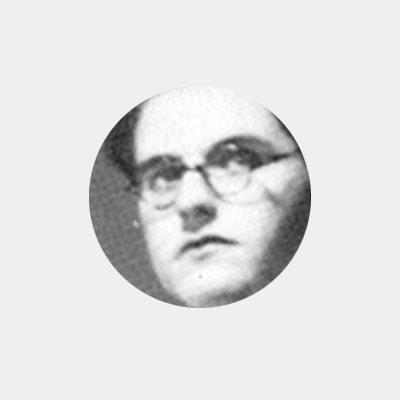Bartomeu Rosselló-Pòrcel
Nou diccionari 62 de la literatura catalana (New Dictionary of Catalan Literature, Edicions 62)
His primary education was in a religious school after which he went to the Institute Balear state school for his secondary education. Here he met Gabriel Alomar, who influenced his literary vocation and encouraged him to write for the local newspapers.
Palma de Mallorca, 1913 – El Brull, Osona, 1938. Poet, essayist and translator
These years of literary apprenticeship were marked by his efforts to assimilate the poetic tradition. Between 1927 and 1929 nine of his poems, in styles ranging from humorous digs at manners and mores, to religious poems and the idealisation favoured by the Mallorca School, appeared in the review Luz y vida, which was published by the monks of the Theatine order. The prestigious Mallorcan newspaper El Día also published a series of his poems written in Spanish, these being influenced by the subjects covered in the course on literature he was doing at the time: ballads, Calderón, Darío, et cetera. He wrote his last poems in Spanish in 1930 and, in the same year, he produced Antología de poetas mallorquines (Anthology of Mallorcan Poems, Madrid) for which he selected the poems, translated some and wrote the prologue.
In October that year he moved to Barcelona to start a degree in Philosophy and Letters, but the following year he changed to Romance Languages. He went to live in the students’ residence where he met the poet Salvador Espriu and took charge of the institution’s publications. In 1931 he went to Madrid for an Extraordinary Congress of the Federal Union of Hispanic Students. The following year he translated C. F. Ramuz’s The Soldier’s Tale (Història del soldat), and Gide’s Prometheus Unbound (Prometeu mal encadenat). In these early years he published twenty-six poems, still early experimental works which, as such, would be excluded from subsequent books, as well as sixty articles in El Día and, a lesser number in Mirador.
His first book, Nou poemes (Nine Poems), was published in 1933, in a limited edition of one hundred copies. This work reveals how he was shedding the distinctive features of his early poetic career – his attention to literary depiction of manners and mores and linguistic vacillation – to offer a glimpse, subsequently to be clearly defined, of his sympathies with the renovating nuclei of the most modern schools of lyricism, pure poetry in particular, now using syntax based on brief, incisive phrases, with prose rhythms, and original and highly effective imagery along avant-garde lines. This first collection was received somewhat guardedly by some of the critics, who dubbed it circumstantial and anaemic. His Quadern de sonnets (Sonnet Notebook), which appeared a year later, was better received and more widely read. Incorporating the fast, witty rhythms of seventeenth-century conceptismo together with Góngora’s aesthetics and courtly tones drawn from his imitation of baroque models from which he adopted motifs and images sometimes taking on overtones of the turn-of-the-century Decadent Movement, this work clearly showed that change was possible. Of loftier discourse and taking the form of very free adaptations of the sonnet, these poems were small gems thanks to the limits imposed on them by the form.
After finishing his degree, he moved to Madrid to work on a doctoral thesis in which he explored the style of Baltasar Gracián, while he also taught and wrote an essay on Quevedo’s poetry as well as a study on Jorge Guillén.
The Spanish Civil War broke out while he was preparing to apply for a position as assistant head of a secondary school. He returned to Barcelona and was conscripted but was discharged shortly afterwards for health reasons. At the end of December he was admitted to the El Brull sanatorium on the massif of Montseny, where he died on 5 January 1938 of pulmonary tuberculosis.
His death left unfinished his translation of The Verrine Orations by Cicero and a volume of poems, Imitació del foc (Imitation of Fire), which was published posthumously in 1938 with prologues by Antoni Maria Sbert, Gabriel Alomar and Carles Riba, the latter of whom he had met while at university. This work, dedicated to Salvador Espriu, consists of thirty poems divided into three sections: “Fira encesa” (Flaming Fair), “Rosa secreta” (Secret Rose) and “Arbre de flames” (Tree of Flames). It is the consolidation of a poetic oeuvre that is notable for its diversity of styles and models – ranging from traditional folk songs to the baroque styles of Góngora and Vicenç Garcia, influences from the avant-garde movement of the period of the First World War, through to the post-symbolism of Carner, Riba, Paul Valéry and Rilke, inter alia – all of which had been foreshadowed in his previous collections of poems. Now it was presented for the first time as a coherent body of work that had moved beyond the preliminary exercises in technique and testing of forms that characterised his earlier poetry.
Obra poètica (Poetic Work) was published in Mallorca in 1949 (and reissued in 1975) with a study by Miquel Dolç and a Prologue by Salvador Espriu, the poet who was later to ensure that his name would become a byword for literature, thus raising him to legendary status.
Copyright text © 2000 Edicions 62




